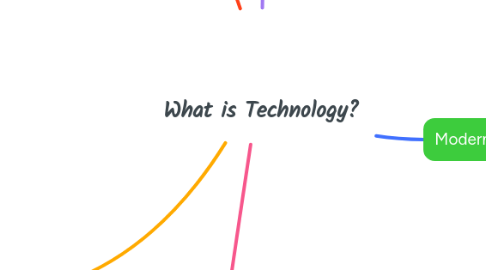
1. Why we need new technologies?
1.1. Healthcare
1.1.1. Major Advancements in modern techologies that are significantly decreasing death rates.
1.1.1.1. Healthcare changes dramatically because of technological developments, from anesthetics and antibiotics to magnetic resonance imaging scanners and radiotherapy. Future technological innovation is going to keep transforming healthcare, yet while technologies (new drugs and treatments, new devices, new social media support for healthcare, etc) will drive innovation, human factors will remain one of the stable limitations of breakthroughs. (Harold Thimbleby, 2013)
1.2. Technology as Social Usage
1.2.1. Technology has permanently changed how we communicate and conduct business. It is the most practical tool we have and is always getting new hardware, software, or platforms added. Given how heavily society depends on technology, businesses must employ communication with these tools to succeed. (Lyndsey B, 2020)
1.3. Productivity
1.3.1. Improve productivity within a worksapce to allow for more time spent innovating the current processes.
1.3.1.1. The firms have undergone a complete transformation as a result of technological breakthroughs that have streamlined and highly integrated their business processes. This is especially true for small and medium-sized businesses. Small firms, which are often run by a few individuals, depend heavily on technology. These companies are operating more efficiently and effectively than ever thanks to technological improvements. (Prasad A, 2020)
2. What I Thought Technology Was.
2.1. Phones
2.1.1. Laptops
2.1.1.1. Cameras
2.1.2. Automobiles
2.2. A version of devices replaced by traditional means of communication. Devices equiped with Aritificial Intelligence. Devices that enhance the quality of life.
3. Refrences
3.1. Li-Hua, R. (2007), "What is technology?", Journal of Technology Management in China, Vol. 2 No. 3. https://doi-org.library.sheridanc.on.ca/10.1108/jtmc.2007.30202caa.001
3.2. B, L. L. (2020). 6 ways technology has changed Communication Forever. Persist Communications. https://forpersist.com/6-ways-technology-has-changed-communication-forever/
3.3. Thimbleby H. (2013). Technology and the future of healthcare. Journal of public health research, https://doi.org/10.4081/jphr.2013.e2
3.4. Thierer, A. (2021, July 25). Defining "technology". Technology Liberation Front. https://techliberation.com/2014/04/29/defining-technology/
3.5. Prasad, A. (2020, January 17). 10 ways technology has reshaped the modern workplace. QuickFMS. https://www.quickfms.com/blog/how-technology-has-reshaped-the-workplace
3.6. Kumar, V., Kumar, U., & Persaud, A. (1999). The Journal of Technology Transfer, https://doi.org/10.1023/a:100772892112
3.7. İŞMAN, D. A. (2012). TheTurkishOnline Journal of Educational Technology. TOJET. http://www.tojet.net/
4. Modern Thoughts on Technology
4.1. Early in the new millennium, many educators and researchers, particularly in the United States, shifted the way they discussed technology and began to emphasize technology as both product AND process of innovation. The American National Research Council (NRC) defined technology simply as including ‘all types of human–made systems and processes’ (2012: 11)
4.1.1. Technology represents the combination of human understanding of natural laws and phenomena accumulated since ancient times to make things that fulfil our needs and desires or that perform certain functions
4.1.2. Isman (2012) summarizes our views pretty well: "When people think of “technology,” they tend to think of human artifacts such as machines, electronic devices, scientific hardware, or industrial manufacturing systems. However, a formal definition (College Dictionary) of technology indicates that it has a more general meaning which includes any “practical application of knowledge” or “manner of accomplishing a task”.
4.2. The UN Conference on Trade and Development (UNCTAD) has provided the following definition:
4.3. Technology is bought and sold as capital goods including machinery and productive systems, human labour usually skilled manpower, management and specialised scientists. Information of both technical and commercial character, including that which is readily available, and that subject to proprietary rights and restrictions. (Li Hua, 2007)
5. What I think technology is now.
5.1. "Technology has two primary components: 1) a physical component which comprises of items such as products, tooling, equipment, blueprints, techniques, and processes; and 2) the informational component which consists of know-how in management, marketing, production, quality control, reliability, skilled labour and functional areas (Kumar, Kumar , & Persuad, 1999).
5.2. Technology, or as it is sometimes referred to, the modification and manipulation of the human environment, is the application of scientific knowledge to the practical goals of human life.
5.2.1. We can also understand this further looking at the work of Thomas P. Hughes, American historian of Technology who said:
5.2.2. "Technology is messy and complex. It is difficult to define and to understand. In its variety, it is full of contradictions…Yet today most people in the industrialized world reduce technology’s complexity, ignore its contradictions, and see it as little more than gadgets and as a handmaiden of commercial capitalism and the military. Too often, technology is narrowly equated with computers and the Internet" (Hughes: 2004: 1).
